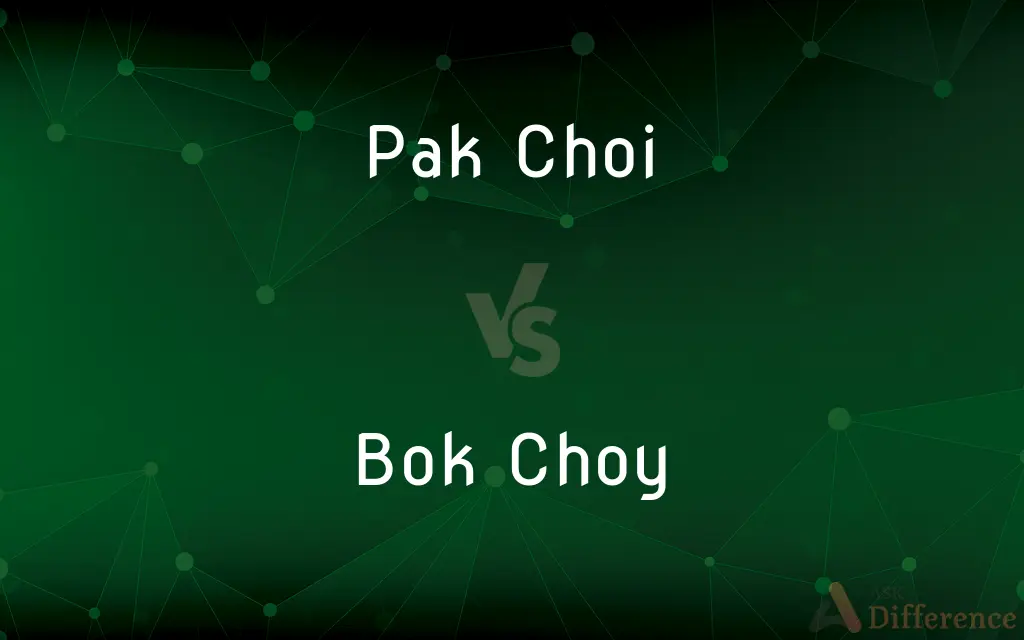Pak Choi vs. Bok Choy — What's the Difference?
By Urooj Arif & Maham Liaqat — Published on March 5, 2024
Pak Choi and Bok Choy refer to the same leafy green vegetable, known for its crisp texture and mild flavor, commonly used in Asian cuisine. The difference lies only in transliteration variations from Chinese to English.

Difference Between Pak Choi and Bok Choy
Table of Contents
ADVERTISEMENT
Key Differences
Pak Choi and Bok Choy are two names for the same vegetable, originating from different Romanization systems used to transliterate Chinese characters into the Latin alphabet. This vegetable is a type of Chinese cabbage, belonging to the Brassica family, and is a staple in many Asian dishes. The naming variation does not signify any difference in the plant itself but rather reflects the diversity in transliteration practices.
The terms "Pak Choi" and "Bok Choy" come from the Cantonese and Mandarin pronunciations, respectively, of the Chinese characters 白菜, which literally mean "white vegetable." This leafy green has a white or pale green stalk and dark green leaves, both of which are edible and prized for their crisp texture and slightly sweet, mild flavor.
Cultivation and consumption of Pak Choi/Bok Choy are widespread, particularly in Chinese, Thai, and Korean cuisines. It can be prepared in various ways, including steaming, boiling, stir-frying, and raw in salads. Its versatility and nutritional profile, rich in vitamins A, C, and K, as well as minerals like calcium and magnesium, make it a popular choice worldwide.
In terms of culinary use, there is no distinction between Pak Choi and Bok Choy. The choice of name often depends on regional language influences or personal preference. Some might argue that different spellings could imply size variations, with "baby bok choy" sometimes referring to a smaller, more tender version of the vegetable, but fundamentally, they represent the same plant.
Understanding that Pak Choi and Bok Choy are the same allows for greater flexibility in following recipes or when shopping, as the name used can vary depending on the source or region. Regardless of the name, this vegetable offers a delightful addition to a wide range of dishes, contributing both flavor and nutritional benefits.
ADVERTISEMENT
Comparison Chart
Name Origin
Cantonese transliteration
Mandarin transliteration
Vegetable
Chinese cabbage
Chinese cabbage
Flavor
Mild, slightly sweet
Mild, slightly sweet
Texture
Crisp
Crisp
Culinary Uses
Versatile in Asian cuisine
Versatile in Asian cuisine
Nutritional Value
High in vitamins A, C, K
High in vitamins A, C, K
Compare with Definitions
Pak Choi
It can be eaten raw or cooked.
I love using fresh pak choi in salads for a crisp bite.
Bok Choy
Both the leaves and stalks of Bok Choy are consumable.
The tender leaves and crisp stalks of bok choy add texture to dishes.
Pak Choi
It is commonly used in Asian cooking.
Pak Choi is a staple in stir-fries and steamed dishes.
Bok Choy
Bok Choy, a type of Chinese cabbage, offers a mild flavor.
Bok choy's gentle taste complements any broth.
Pak Choi
Pak Choi is a leafy green vegetable known for its crisp texture.
I added pak choi to the soup for a crunchy texture.
Bok Choy
Bok Choy can be prepared in numerous ways.
I sautéed bok choy with garlic and soy sauce for a quick side.
Pak Choi
The vegetable is rich in vitamins and minerals.
Pak Choi contributes valuable nutrients like vitamin C to our diet.
Bok Choy
It's a key ingredient in Asian cuisine.
Bok choy is perfect for adding volume and nutrition to noodle dishes.
Pak Choi
Pak Choi's white stalks and green leaves are both edible.
The entire pak choi plant, from stalk to leaf, can be used in cooking.
Bok Choy
This vegetable is packed with vitamins A, C, and K.
Bok choy boosts the healthiness of any meal with its high vitamin content.
Pak Choi
An Asiatic plant (Brassica rapa chinensis) grown for its cluster of edible white stalks with dark green leaves.
Common Curiosities
Is there a taste difference between Pak Choi and Bok Choy?
No, there is no taste difference; the terms simply reflect different transliterations of the same vegetable.
What's the best way to store Pak Choi/Bok Choy?
Store it in a plastic bag in the refrigerator's crisper drawer to maintain freshness for about a week.
Can I use Pak Choi and Bok Choy interchangeably in recipes?
Absolutely, since they are the same vegetable, they can be used interchangeably in any dish.
How do I know whether to buy Pak Choi or Bok Choy?
Choose based on freshness and quality, not the name, as they refer to the same vegetable.
Are Pak Choi and Bok Choy nutritionally the same?
Yes, they are the same vegetable and thus have identical nutritional profiles.
Can Pak Choi/Bok Choy be grown at home?
Yes, it can be easily grown in gardens or containers, preferring cooler weather.
Are there different varieties of Pak Choi/Bok Choy?
Yes, there are several varieties, including baby versions, which are smaller and more tender.
What are the health benefits of eating Pak Choi/Bok Choy?
It's beneficial for bone health, cardiovascular health, and may have anti-inflammatory properties due to its high vitamin and mineral content.
Can Pak Choi/Bok Choy be eaten raw?
Yes, it's delicious raw in salads or as a crunchy snack.
Is Pak Choi/Bok Choy suitable for a low-carb diet?
Yes, it is low in carbohydrates and high in fiber, making it suitable for low-carb diets.
What dishes are Pak Choi/Bok Choy commonly used in?
They're versatile in soups, stir-fries, steamed dishes, and salads.
How do I clean Pak Choi/Bok Choy?
Rinse under cold water to remove any dirt from the leaves and stalks. For thorough cleaning, separate the leaves from the stalks.
How do I prepare Pak Choi/Bok Choy for cooking?
Wash thoroughly and chop as desired. It can be cooked whole, halved, or sliced, depending on the recipe.
Why might some recipes specify Pak Choi over Bok Choy, or vice versa?
The specification is likely due to regional preferences in naming, rather than any difference in the vegetable itself.
Does the size of Pak Choi/Bok Choy affect its cooking time?
Yes, smaller or baby varieties cook faster than larger ones, so adjust cooking times accordingly.
Share Your Discovery

Previous Comparison
Renaissance vs. Middle Ages
Next Comparison
Technical Writing vs. Creative WritingAuthor Spotlight
Written by
Urooj ArifUrooj is a skilled content writer at Ask Difference, known for her exceptional ability to simplify complex topics into engaging and informative content. With a passion for research and a flair for clear, concise writing, she consistently delivers articles that resonate with our diverse audience.
Co-written by
Maham Liaqat















































